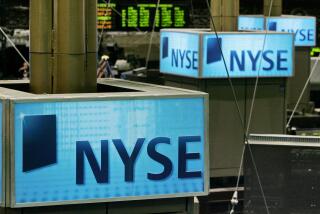Dividends Brighten, Despite IBM
- Share via
IBM’s decision Tuesday to slash its dividend by 55% is the latest in a string of calamities to hit dividend-conscious investors during the last three years. Hundreds of big companies have slashed dividends during the recession-racked 1990s, while others halted regular hikes in their quarterly payouts to shareholders.
Each of the last three years has seen the fewest dividend increases since the early 1970s. Average dividend yields for stocks in the Standard & Poor’s 500 index have dropped to less than 3%--a historically low level that bodes ominously for the market as a whole, says Geraldine Weiss, editor of Investment Quality Trends, a La Jolla-based newsletter for yield-hungry investors. When dividend yields linger below 3% for any sustained period, a market decline usually follows, Weiss says.
Yet despite the bad news, some experts see reason for optimism.
For the first time in three years, dividends this year are expected to rise by more than the rate of inflation, says Arnold Kaufman, editor of Standard & Poor’s Outlook, an investment newsletter. Kaufman predicts a 6% overall boost this year in dividends paid by companies in the S&P; 500. And a handful of big, financially strong firms may hike dividends far more, Weiss adds.
*
Indeed, Weiss predicts, such giants as Coca-Cola, General Electric, McDonald’s, Merck, J. P. Morgan and Philip Morris will announce dividend hikes of at least 10% this year. If the stock market retreats in the next several months--as some predict--yield-conscious investors ought to consider investing in their stocks, she says. (She doesn’t encourage investors to buy now because she thinks stock prices are too lofty.)
The dividend picture is brightening for several reasons, analysts say.
First, the U.S. economy is recovering, but slow enough that it’s not spurring inflation and higher interest rates. Low interest rates allow corporations to finance growth cheaply. Firms can also refinance old debts at lower rates, cutting interest expenses and boosting profits.
Meanwhile, many big companies also restructured in recent years, becoming leaner and more efficient. That should make them significantly more profitable, analysts say. Profitability for companies in the S&P; 500 is expected to rise by 20% or more, experts note.
And because dividends are usually a reflection of profitability, they should climb, Kaufman says.
Still, as IBM stockholders can painfully attest, there are risks to investing for dividends. Most notably, companies are not generally obligated to pay any set amount to common shareholders. When these firms get in financial trouble, their dividends often get cut--and the stock price tends to follow.
Before IBM announced last year that its dividend was in jeopardy, its stock was selling for as much as $90 a share. It closed Tuesday at $49.
Then, too, firms that pay the biggest dividends also tend to be growing the slowest. Fast-growing companies must reinvest most of their profits to continue expanding; slow-growers don’t. And, as a rule, slow-growing companies don’t knock anyone’s socks off with share price gains.
Indeed, many analysts contend, investors can do better by investing in shares of small, fast-growing companies that may not pay dividends at all. These companies in recent years have produced better overall results than firms--such as utilities--paying high dividends.
For example, mutual funds that invest in dividend-producing stocks earned 82.43% on average over the last five years, versus a 125.46% return for funds investing in small-company growth stocks, according to Lipper Analytical Services in New York. Returns last year for equity income funds--which invest in dividend-oriented stocks--averaged 9.46% versus 12.54% for small-company growth funds.
However, other experts note that growth stocks are more volatile than dividend-producing stocks. The only thing supporting the stock prices of small, non-dividend payers is their growth prospects. When sales and earnings aren’t up to expectations, their share prices get pummeled, sometimes falling 15% or 20% in a single day. Investors unwilling or unable to handle such big jolts are wise to stick with dividend-paying stocks, which tend to be a bit steadier.
Additionally, even though growth stocks are currently in vogue versus income-oriented stocks, these trends tend to go in cycles, experts note. One indication: While growth stocks outperformed dividend-producing stocks over the last five years, dividend producers outperformed growth stocks over the last 10 years, according to Lipper. Specifically, equity income funds earned 250.18% since 1982 versus 220.9% for small-company growth funds.
More to Read
Inside the business of entertainment
The Wide Shot brings you news, analysis and insights on everything from streaming wars to production — and what it all means for the future.
You may occasionally receive promotional content from the Los Angeles Times.










